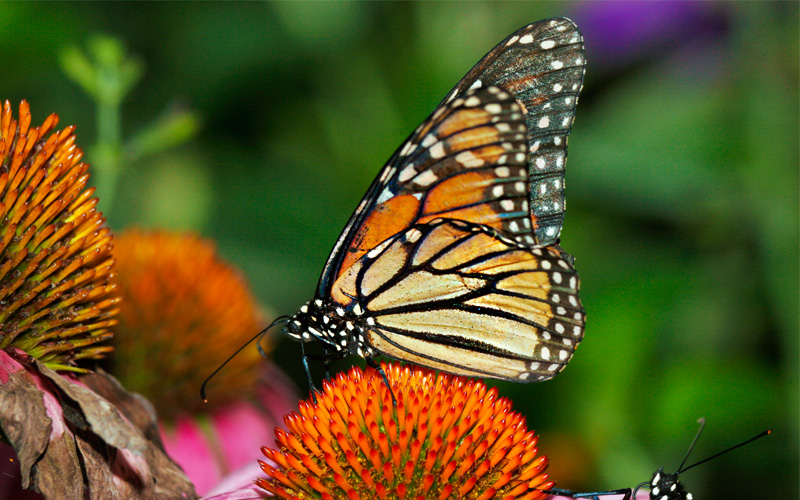
Everyone loves a monarch butterfly! They are a magical symbol of summertime, transformation, and the health of the environment. But let’s face it; they’re a bit complicated to understand. Even though I’ve long appreciated how amazing they are, I didn’t get how the whole monarch migration thing worked. And why do they need milkweed? Is that all they eat, or what?
So I did a little research (what did we do before Google?) and was even more amazed by the magic of their precious lives. So I’m going to try to explain it all for you here (focusing on the eastern monarch) so that you too can appreciate just how special these butterflies are and how much their survival depends on your help.
1. First of all, it takes FOUR GENERATIONS of monarchs to fly from Mexico to their final East Coast destination. That’s four generations in one summer! And each generation along that migratory path needs the same few things.
2. What consists of one generation of a monarch? A monarch leaves Mexico, mates ;-), lays eggs; a caterpillar is born and eats until it feels the urge to turn into a pupa or chrysalis, then it comes out a butterfly and repeats the process, flying north the whole way. This happens four times every summer.
3. Baby monarch caterpillars can only eat one thing: milkweed! Milkweed is like infant monarch baby formula. In fact, milkweed is toxic to almost every other bird, animal, and insect. So it really only fits into the food chain as a food for baby monarch caterpillars (which are yellow-, black-, and white-striped little cutie pies), and it makes those adorable little caterpillars distasteful to predators. This is why it’s important for us to make sure there is milkweed all the way from Mexico to Maine! And maybe even Canada.
4. Milkweed is useful for other things, too, by the way. The feathery seeds can be used for stuffing things (Native Americans used it as diaper padding), the stalks can be made into rope, and the plant has a number of medicinal uses, as well.
5. Back to the monarchs. Adult monarch butterflies eat nectar from any tasty flower. That’s why it’s good to create a butterfly garden for all the butterflies, filled with lots of delicious flowers. They need their strength to fly the next leg of their journey (and to mate and then lay eggs, preferably on milkweed so when their babies are born they have something to eat).
6. Then the miracle happens: The monarchs of the final, fifth generation are super butterflies! This last generation flies ALL THE WAY BACK TO MEXICO themselves! That’s, like, thousands of miles!
7. Some more interesting facts: Monarchs are found all over the world, but in areas where it’s warm, they don’t migrate—or they take a much smaller round trip. Monarchs have become especially fond of Bermuda and Spain, since people have started planting milkweed as an ornamental plant in those countries. Monarchs have even been known to fly across oceans!
How do they know the way? Well, that’s the great mystery and a reminder of just how much we don’t know about nature, the universe, and life in general. I have a few theories, but those will have to wait for another day. In the meantime, enjoy, protect, and nurture these magical creatures.
Endnote: This week at Rodales.com, in honor of the monarch butterfly, there is a game you can play to find the monarch on the site and get free shipping on any order. Plus, we now sell certified-organic milkweed seeds so you can plant a monarch nursery of your very own.




I used to have 2 Butterfly bushes and lots of Cosmos flowers, just 2 of the flowers Monarchs love. I now live in an apartment but still have some pots on the balcony for Cosmos flowers. Each year I would watch for the butterflies, each year there were fewer and fewer until I could count the number of Monarchs I saw on one hand. Today I looked out my 4th floor window and down below saw one lone butterfly, all yellow, so don’t think it was a Monarch. I just love butterflies and sign every petition I can to try to stop companies like Monsanto and Bayer from spreading pesticides around the world which are killing our bees. We are losing so many colonies that some farmers are afraid they won’t have crops. If you love butterflies, please don’t use harmful pesticides on your lawns or gardens. In the end it will not only kill the butterflies but us as well.
I’m really interested in helping the monarch butterflies ever since we saw an IMAX movie about them. I’ve got milkweed going throughout my yard and hope to have a nice collection of nectar plants as well. I hope some stop to see me, I’m going to be ready for them!
We have quite a bit of milkweed growing wild in our back field. It’s so exciting to see the Monarchs every year. This year I want to save and plant some seeds to expand the patch.
Great article covering the basics! Important to note that the Nov 1, 2013 Monarch Count in Mexico was down from 65 million in 2012 to just 3 million in 2013! Some scientists fear that this may be the last great monarch migration – which incidentally is the largest insect migration in the world. Planet Rehab is working with cities, businesses, churches, etc., as well as individuals, to plant Butterfly Gardens that contain Native Milkweed Plants. It would be awesome if your readership did the same thing by contacting their local city governments as well as other entities! Bravo for covering this urgent topic!